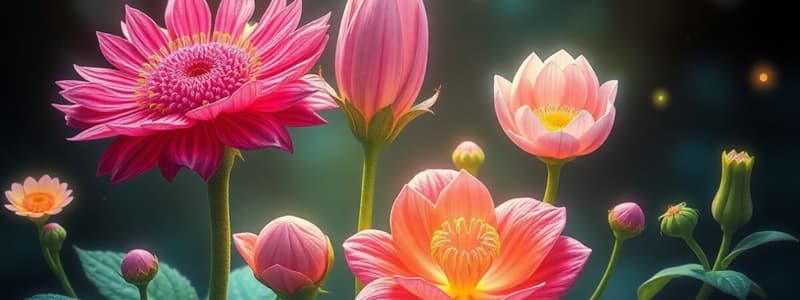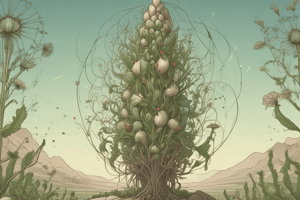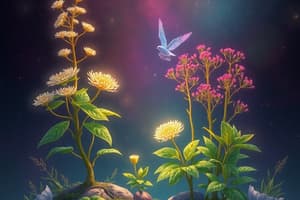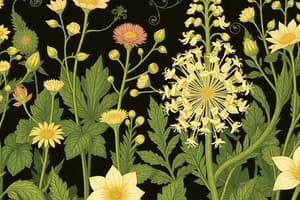Podcast
Questions and Answers
Which of the following is NOT a key adaptation that arose following seedless vascular plants?
Which of the following is NOT a key adaptation that arose following seedless vascular plants?
- Seeds
- Reduction of Gametophytes
- Flowers
- Vascular tissue (correct)
In seed plants, the gametophyte generation is typically the dominant, visible stage of the life cycle.
In seed plants, the gametophyte generation is typically the dominant, visible stage of the life cycle.
False (B)
In seed plants, what structure protects the male gametophyte and facilitates its dispersal?
In seed plants, what structure protects the male gametophyte and facilitates its dispersal?
pollen
What is a significant advantage of heterospory over homospory?
What is a significant advantage of heterospory over homospory?
The seed coat is derived from the ______ of the ovule.
The seed coat is derived from the ______ of the ovule.
Match the gymnosperm division with its description:
Match the gymnosperm division with its description:
What is the primary role of flowers in angiosperms?
What is the primary role of flowers in angiosperms?
Gymnosperms rely on fruits to disperse their seeds.
Gymnosperms rely on fruits to disperse their seeds.
What is the term for the movement of pollen from the male part of a flower to the female part?
What is the term for the movement of pollen from the male part of a flower to the female part?
The fusion of haploid gametes to form a diploid zygote is called ______.
The fusion of haploid gametes to form a diploid zygote is called ______.
Which of the following best describes a key difference between pollination and fertilization in plants?
Which of the following best describes a key difference between pollination and fertilization in plants?
Wind-pollinated flowers typically have bright, showy petals to attract pollinators.
Wind-pollinated flowers typically have bright, showy petals to attract pollinators.
What type of floral adaptation would you expect to see in a flower pollinated by nocturnal animals, such as bats?
What type of floral adaptation would you expect to see in a flower pollinated by nocturnal animals, such as bats?
Which gymnosperm division includes plants with fan-like leaves and only one extant species?
Which gymnosperm division includes plants with fan-like leaves and only one extant species?
The term 'conifer' means '______ to carry'.
The term 'conifer' means '______ to carry'.
Match the following pollinators with typical flower characteristics:
Match the following pollinators with typical flower characteristics:
In angiosperms, what is the primary function of the fruit?
In angiosperms, what is the primary function of the fruit?
Fruits always provide nourishment to the seeds they contain.
Fruits always provide nourishment to the seeds they contain.
In the angiosperm life cycle, what structure develops into the seed?
In the angiosperm life cycle, what structure develops into the seed?
Double fertilization is unique to ______ and involves one sperm fertilizing the egg and another sperm fertilizing the central cell.
Double fertilization is unique to ______ and involves one sperm fertilizing the egg and another sperm fertilizing the central cell.
Which event leads to the production of pollen grains?
Which event leads to the production of pollen grains?
Gymnosperms dominated Mesozoic terrestrial ecosystems.
Gymnosperms dominated Mesozoic terrestrial ecosystems.
What adaptations facilitated colonization of land?
What adaptations facilitated colonization of land?
Which of the following characteristics distinguishes angiosperm seeds from gymnosperm seeds?
Which of the following characteristics distinguishes angiosperm seeds from gymnosperm seeds?
Conifers are Cycadophyta.
Conifers are Cycadophyta.
The long, thin beak and tongue enable the animal to probe flowers that secrete nectar deep with in floral tubes. This pollinator is a ______.
The long, thin beak and tongue enable the animal to probe flowers that secrete nectar deep with in floral tubes. This pollinator is a ______.
Which type of flowering attracts pollinators?
Which type of flowering attracts pollinators?
Monocot are Eudicots.
Monocot are Eudicots.
What type of flowering is found at the top, and then hangs down?
What type of flowering is found at the top, and then hangs down?
______ brings pollen to the female parts.
______ brings pollen to the female parts.
Which species has both ovulate and pollen cones?
Which species has both ovulate and pollen cones?
Gymnosperm seeds are 'naked seeds'.
Gymnosperm seeds are 'naked seeds'.
What type of adaptation that protects from UV and desiccation?
What type of adaptation that protects from UV and desiccation?
Flowers attract ______.
Flowers attract ______.
Which of the following characterizes angiosperms?
Which of the following characterizes angiosperms?
Water lilies and star anise are Basal Angiosperms
Water lilies and star anise are Basal Angiosperms
Which animals help carrion flowers?
Which animals help carrion flowers?
______ Bribe Animals to Disperse Seeds.
______ Bribe Animals to Disperse Seeds.
What does wind-pollinated flowers tend to be?
What does wind-pollinated flowers tend to be?
Humming bird pollinated flowers are unscented.
Humming bird pollinated flowers are unscented.
Which of the following adaptations in seed plants allowed them to colonize terrestrial environments?
Which of the following adaptations in seed plants allowed them to colonize terrestrial environments?
In gymnosperms, pollen grains make their way directly to the ovule and fuse with the egg to form a diploid zygote.
In gymnosperms, pollen grains make their way directly to the ovule and fuse with the egg to form a diploid zygote.
The process where one sperm fertilizes the egg and another fuses with the central cell to form endosperm is called ______.
The process where one sperm fertilizes the egg and another fuses with the central cell to form endosperm is called ______.
Match the following gymnosperm divisions with their descriptions:
Match the following gymnosperm divisions with their descriptions:
Flashcards
Alternation of Generations
Alternation of Generations
A life cycle in plants where there are alternating generations between sporophytes and gametophytes.
Bryophytes
Bryophytes
Nonvascular plants (e.g., mosses) that lack specialized vascular tissues.
Pterophytes
Pterophytes
Vascular plants (e.g., ferns) with specialized tissues for transporting water and nutrients.
Diploid Resistance to UV
Diploid Resistance to UV
Signup and view all the flashcards
Seeds
Seeds
Signup and view all the flashcards
Pollen
Pollen
Signup and view all the flashcards
Heterospory
Heterospory
Signup and view all the flashcards
Flowers
Flowers
Signup and view all the flashcards
Female Gametophyte
Female Gametophyte
Signup and view all the flashcards
Male Gametophyte
Male Gametophyte
Signup and view all the flashcards
Pollination
Pollination
Signup and view all the flashcards
Fertilization
Fertilization
Signup and view all the flashcards
Gymnosperms
Gymnosperms
Signup and view all the flashcards
Gymnosperm Cones
Gymnosperm Cones
Signup and view all the flashcards
Angiosperms
Angiosperms
Signup and view all the flashcards
Fruit
Fruit
Signup and view all the flashcards
Angiosperm Ovary
Angiosperm Ovary
Signup and view all the flashcards
Simple Fruits
Simple Fruits
Signup and view all the flashcards
Aggregate Fruits
Aggregate Fruits
Signup and view all the flashcards
No seed nourishment
No seed nourishment
Signup and view all the flashcards
Angiosperm Diversity
Angiosperm Diversity
Signup and view all the flashcards
Why Spend All That Energy Producing a Flower?
Why Spend All That Energy Producing a Flower?
Signup and view all the flashcards
Wind Polinated Flowers
Wind Polinated Flowers
Signup and view all the flashcards
Study Notes
Plant Diversity II: The Evolution of Seed Plants
- Adaptations played a key role in the colonization of land
- The password for the online content is genes
Review
- Alternation of generations is a key concept
- Distinguishing between bryophytes and pterophytes is essential
Adapting to Land
- Five key adaptations occurred after seedless vascular plants evolved
Reduction of Gametophytes
- Gametophytes experienced reduction
- A diploid state offers enhanced resistance to UV mutation
Seeds
- Seeds contain an embryo, food and a resistant coat
- Seeds facilitate dispersal
Pollen
- Pollen houses the male gametophyte
- Pollen uses wind to disperse
- Pollen does not need flagella and is desiccation-resistant
Heterospory
- Male and female gametophytes are separate
- There is a miniaturization of gametophytes
- There is protection from desiccation and UV radiation
Flowers
- Flowers attract pollinators exclusively in angiosperms
Female Gametophytes
- Megasporangium produces a megaspore
- The megaspore then creates a female gametophyte, producing an egg inside the ovule
- The ovule consists of the megasporangium, megaspore, and integument
Male Gametophytes
- Microsporangium generates a microspore
- The microspore then creates a male gametophyte or pollen, which then produces sperm
Pollination vs Fertilization
- Pollination is the movement of pollen (male gametophyte) to the ovules (female gametophyte)
- Fertilization involves the fusion of haploid gametes, resulting in a diploid zygote
Heterospory Benefit
- Heterospory provides protection from UV and desiccation
Gymnosperms
- Gymnosperms feature seeds that aren't enclosed in fruits, "naked seeds"
- Divisions in gymnosperms includes:
- Cycadophyta - cycads
- Ginkophyta - ginkgoes
- Coniferophyta - conifers
- The word conifer means cone to carry
- In Gymnosperms, male and female gametophytes are on different cones
Gymnosperm Timeline
- Gymnosperms shows up early in the fossil record
- They dominated the Mesozoic terrestrial ecosystems
Angiosperms
- Characterized as true flowering plants
- Angiosperms are in the division Anthophyta with - all known flowering plants
- Angiosperms show a marked reduction in the gametophyte generation
- Flowers are their reproductive structures
- Fruits are the ripened ovary
- They have a function to protect seeds
- Fruits facilitate in seed dispersal
Flower Production
- Energy is required to make flowers
Pollination
- Pollination happens when pollen is moved to female parts
Adaptations in Wind-Pollinated Flowers
- Wind pollinated flowers tend to be inconspicuous
Grass Flower Traits
- Grass flowers are found at the top of the plant and then hang down
Carrion Flowers
- Carrion beetles are a job for carrion flowers
Paw-Paw Pollination
- Growers will use rotting fish on trees to try and attract pollinators.
Traits in Fleshy Fruits
- They have soft outer and inner layers of pericarp
Seed dispersal in Wild Berries
- Wild berries can contribute to the spread of seeds
Burrs
- Burrs adhere to animal coats to travel
Angiosperm Traits
- There is a relationship between the flower and fruit
- The fruit offers no nourishment to the seeds
Angiosperm vs. Gymnosperm Seeds
- A key differences is that angiosperm seeds are found within an ovary
Angiosperm Diversity
- Basal angiosperms are less derived and come from the oldest flowering plant lineages
- Magnoliids share traits with basal angiosperms, but related to monocots and eudicots
Angiosperm Main Groups
- Monocots and eudicots are the two groups of angiosperms
Basal Angiosperms
- Amborella, Water Lilies, Star anise are types of basal angiosperms
Studying That Suits You
Use AI to generate personalized quizzes and flashcards to suit your learning preferences.




